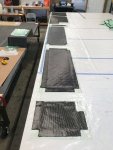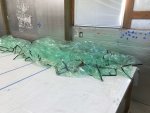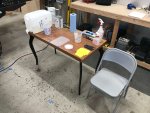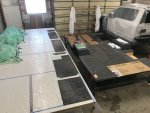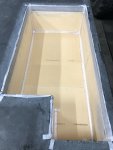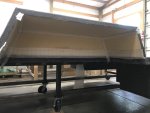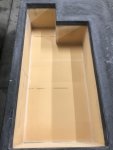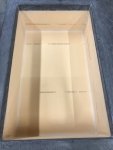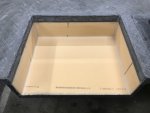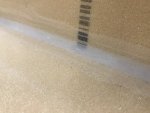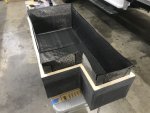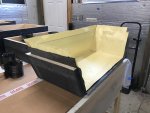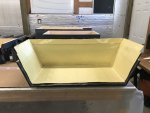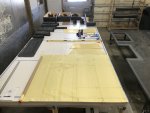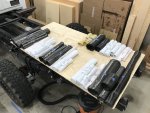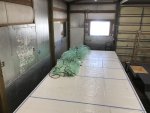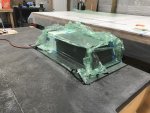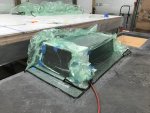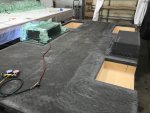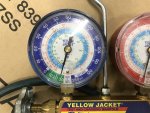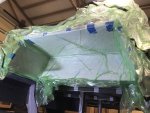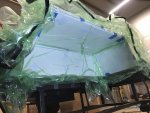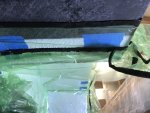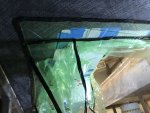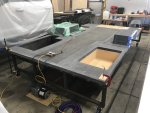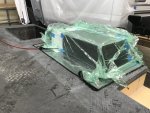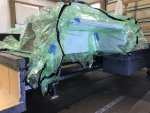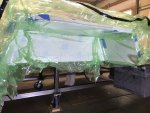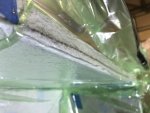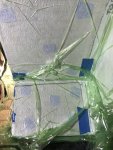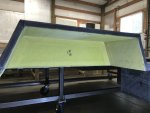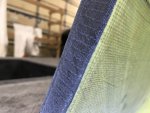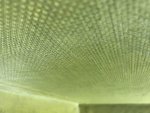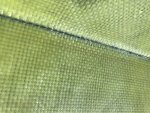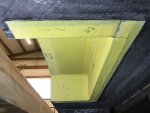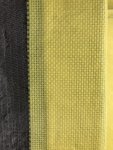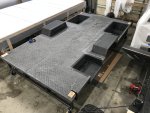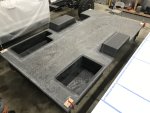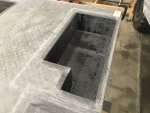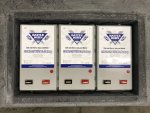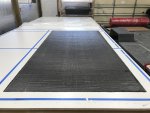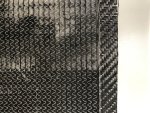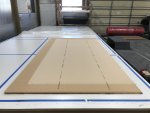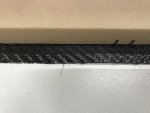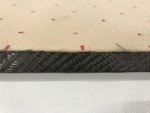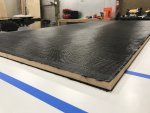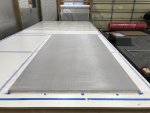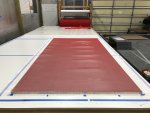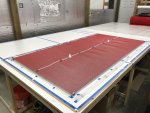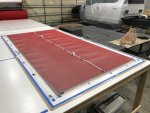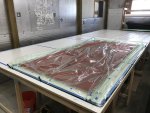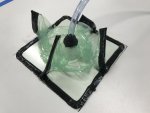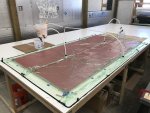CF Floor Boxes & Wheel Well Layups #2 - Inside - (Continued......)
So I thought I would include the inside layup schedule of material for each box/wheel well.
Note: All seams/joints in the material are overlapped by 2". All material changes direction/orientation with each layer.
Wheel Wells:
Base layer-CF 9.5oz plain weave
Second layer-CF 24oz biaxial 45/45 stitched
Third layer-Kevlar 9.15 oz plain stitched
Fourth layer-Kevlar 5 oz plain weave
Notes:
- Tabbing: Base/Second layer-2" onto vertical edge of cut out in floor. Third layer-4" (2" onto vertical edge of cut out in floor and 2" on underside of floor. Fourth Layer-5" (2" onto vertical edge of cut out in floor and 3" on underside of floor.
- The vertical front/face edge of the wheel well, that the side wall will sit on top of, is wrapped/overlapped with the 9.5oz plain weave and 24oz biaxial 45/45 stitched. This adds additional structural support to the wheel well, where the side wall will sit on top of and be tabbed to the wheel well.
- After the walls are in place and tabbed to the side/underside of the floor/wheel wells, I will most likely add one or two more layers of Kevlar to the underside of the wheel wells, for a total weight of 30-40oz. This will add a cap over the edges of the tabbing material for the walls on the underside of the wheel wells, as well as create some additional thickness of Kevlar for those pesky little rocks that may want to try and put a hole or dent in the bottom of my wheel wells. I will also coat the bottom of the wheel wells with Line-X or equivalent for added protection.)
Base layer-CF 9.5oz plain weave
Second layer-8.85 oz biaxial 45/45 stitched (plug piece on bottom of box only-comes up walls 2")
Third layer-CF 24oz biaxial 45/45 stitched
Notes:
- Tabbing: Base layer-3" (2" onto vertical edge of cut out in floor and 1" on top side of floor. Third layer-4" (2" onto vertical edge of cut out in floor and 2" on top side of floor.
- The vertical front/face edges are wrapped/overlapped with the 9.5oz plain weave and 24oz biaxial 45/45 stitched. This adds additional structural support to the step box, where the entry door will sit on top of.
Battery Box:
Base layer-CF 9.5oz plain weave
Second layer- CF 8.85 oz biaxial 45/45 stitched
(Plug piece on bottom of box that comes up walls 2", as well as has four 6.5" wide strips that come up the side walls of the box and act as two larger hanger straps that stiffen and reinforce the plug and weight the box will see from the batteries. See picture below if needed.)
Third layer-CF 9.5oz plain weave
(Two 8.5" wide strips that span the entire width of the box (bottom & side walls), sit directly centered on top of the 8.85oz strips/hangers, act as two larger hanger straps that stiffen and reinforce the box and are spaced to divide the box into thirds. See picture below if needed.)
Fourth layer-CF 24oz biaxial 45/45 stitched
Notes:
- Tabbing: Base layer-3" (2" onto vertical edge of cut out in floor and 1" on top side of floor.) Second/Third layer strips/hangers- 2" onto vertical edge of cut out in floor. Fourth layer-4" (2" onto vertical edge of cut out in floor and 2" on top side of floor.)
 Water Box:
Water Box:
Base layer-CF 9.5oz plain weave
Second layer- CF 8.85 oz biaxial 45/45 stitched
(Plug piece on bottom of box that comes up walls 2", as well as has four 10" wide strips that come up the side walls of the box in the main/larger area of the box and two 4" wide strips that come up the side walls of the box in the smaller side area of the box. The strips act as three larger hanger straps that stiffen and reinforce the box. The strips/hanger straps are spaced to divided the box into fourths. See pictures below if needed.)
Third layer-CF 9.5oz plain weave
(Plug piece on bottom of box that comes up walls 3", as well as has four 12" wide strips that come up the side walls of the box in the main/larger area of the box and two 6" strip for the smaller side area. The strips/hanger sit directly centered on top of the 8.85oz strips/hangers.)
Fourth layer-CF 24oz biaxial 45/45 stitched
Notes:
- Tabbing: Base layer-3" (2" onto vertical edge of cut out in floor and 1" on top side of floor.) Second/Third layer strips/hangers- 2" onto vertical edge of cut out in floor. Fourth layer-4" (2" onto vertical edge of cut out in floor and 2" on top side of floor.)
Base and second (covered)/third layer plugs
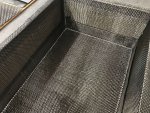
Second/third layer strips/hanger material
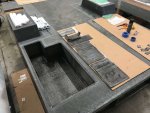
Here is everything layed out and prepped right before the layup of the water box
